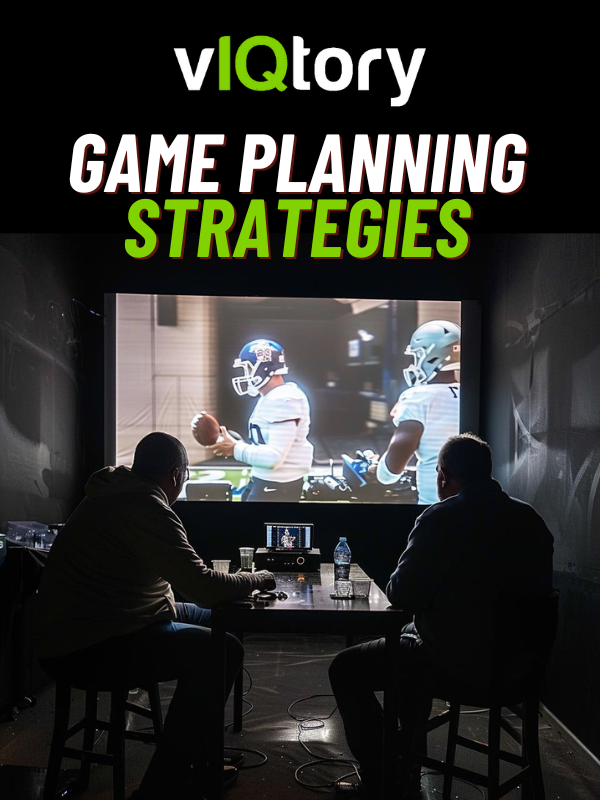For passing attacks to be successful, the quarterback must master the 3, 5, 7 steps and quick game footwork.
The quarterback must have a mixed back of fundamentals. A big part of the QB’s fundamentals is their footwork. QBs must have quick, rhythmic feet when dropping back to pass.
In this article, we’re going to teach you about the 3, 5, and 7 step drops and how offenses use a quick game to throw the football downfield.
Quarterback Drops Introduction
A quarterback will have a designated amount of steps that he should take on every passing play in football. This is to ensure that the timing of the play works out.
Most coaches highly emphasize timing for quarterbacks. QBs need to take the proper steps because the receivers are running specific routes depending on the QB’s drop is, and the offensive line is blocking a certain way.
3 Step Drop
The first drop we will discuss is the 3-step. The 3-step is typically meant for quick game concepts, meaning that the receiver’s routes will be short. The quarterback must drop back quickly and get the ball out of his hands.
The first separation step from the line is crucial. If the QB is right-handed, his right leg will go back first, and vice versa if he’s a lefty. A “False step” can affect the play’s timing poorly.
After the first separation step, the QB will crossover using his other leg. Then, on the third step, he will be planted and ready to throw the ball. If the QB is taking a shotgun snap and is still a quick game concept, he will take a 1 step drop to keep the same timing. There is also no need for them to drop back further since they already have a separation by being in the shotgun.
5 Step Drop
A 5 step drop from under center is harder than a 3 step drop. However, they are both similar. For a 5 step drop, the routes associated with it will be longer developing routes. They are usually intermediate to deep routes. A few examples may be a post, curl, corner or dig.
Like a 3 step, the quarterback’s first step will get distance from the line of scrimmage, and then he will crossover and plant. He will crossover again after he plants his 3rd step and then plants to get to his 5th step. The QB may release the ball on his 5th step or reset his feet depending on the route.
During a 3 step drop, the QB should never take a hitch step since he is already close to the line of scrimmage. The offensive line will not expect him to move up in the pocket. However, for a 5 step drop, the QB is enough away for the quarterback to climb up in the pocket.
Another key point that QBs must know regarding footwork is that they have to drop straight back. The offensive line expects the QB to drop straight back, blocking their defenders based on the path. If the QB is in shotgun and the offense runs a 5 step concept, he will take a 3 step drop.
7 Step Drop
The 7 step drop is rarely used at the youth or high school level. It is used more in college and at the pro level.
It also requires a solid offensive line since it is long developing. Concepts associated with the seven steps are usually “Shot plays.” This is when the coach wants to take a stab at a play downfield. Usually, this is a six man protection or a “Max protection,” meaning there will be 7 or 8 players to protect the QB.
Routes that can be thrown off a 7 step may be flys, deep posts, post corner, post dig, and corner post. A QB’s footwork for a 7 step drop is the same steps as a 5 step, except now with an extra crossover and plant. If the QB is in the gun and the team runs a 7 step concept, they will take a 5 step drop.
Learn How To Watch Film Properly…
Uncover your opponent’s offensive and defensive tendencies so you can easily build a game plan.
Inside You’ll Find:
- Strategies to pick apart defenses
- How to identify player weaknesses
- How to save time in your weekly breakdowns
Quick Game In Football
Now, let’s apply the 3 step drop. As I mentioned in the 3 step section, the QB must release the ball on his 3rd step or soon after. Quick game routes are short routes where the QB can get the ball out as fast as possible.
The first quick game route I will mention is the “hitch.” On this concept, every receiver is running a 5-yard hitch. The QB must make a pre-snap read to determine where they will most likely throw the ball. For example, if the cornerback is 10 yards off from a wide receiver, the QB will take the easy, quick game throw.
The next concept I will talk about is “Slant-flat.” This may be mirrored on both sides of the field. The quarterback’s pre-snap read will determine which side he is throwing the ball on.
For example, if there are three defenders on one side of the field and only two on the other, the QB should go where there are two defenders. Once the ball is snapped, the QB should read the linebacker lined up on the slot receiver. If he runs to the flat, the slant should be thrown. If he stays home in a zone, the flat should be thrown.
Which Quarterback Drops Should I Learn First?
The step drop from under the center should be taught first. Without a solid 3 step, the QB will not have a good 5 or 7 step. The 1 step from the shotgun should also be taught at the same time as the 3 steps from under the center.
How Do I Improve My Drop Backs As a Quarterback?
This is something that will take lots of reps. Film yourself doing it and ask other coaches / experienced players to help you out. Watch how a lot of pro-QBs drop back. Once you find out what you’re doing wrong, there are many drills you can do to get better. Reference the video above for visual help.
Keep Learning
The quarterback position is one of the hardest positions in football to play. That’s why we created the Quarterback University course. You don’t need to stress anymore about mechanics or fundamentals. We have it all here for you.
Learn more about the quarterback position by reading the articles below.
How To Play Quarterback In Football
Why Quarterbacks Slide When They Run
Why Does The Quarterback Lift His Leg?
Quarterback Communication Before The Ball Is Snapped
The quarterback must always know what he is taking for a dropback to ensure the play’s timing is there. They must also understand why they are taking that drop on each particular play.
The QB has a tremendous amount of pressure to succeed. To succeed under that pressure, they must master the proper footwork.


